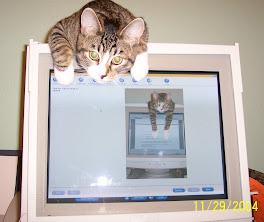Just as entertaining, however, are the essays where Disbrowe recalls the animals, places, and insects she encountered after moving to Whistle Berry Ranch in the Nueces Canyon ~ and the learning curve inherent in the transition from New Yorker to Texan. Her essay about adopting orphan goats left me not only laughing but also wistful with the memories of kid goats and gentle nannies that we had when I grew up on a hobby farm in California. I used to love those silly creatures. Their antics, their affectionate natures (sometimes), and their energy. I still sometimes walk outside on a spring morning and think, "I wish we had a couple of goats."
There are several recipes in the collection that look wonderful, including many for game birds, venison, and antelope along with the expected beef and fish. The photography is both lush and personal: along with the requisite pics of sliced limes and plates of cheese-drenched chilis there are lots of portraits of Disbrowe, her husband, friends and their animal menagerie. But, aside from that astonishingly good tomato soup, it's the essays that are most memorable.
What I like about Disbrowe's writing is that she manages to be both self-deprecating and smart. Her tone is funny, warm and sincere, and reading her essays you can easily understand why she looks back with warmth and humor on the first calving at their little ranch ~ when she and her husband struggled to weigh 90-pound calves by holding them and standing on a bathroom scale (they didn't want to ask the local ranchers how to do everything). Of course they got wiser and learned to get a livestock scale, but she writes,
"part of me missed the earnest chaos of our earlier attempts. There was something pure and poignant in how little we knew and the logic we thought we could apply. And we got the job done after all."My only complaint about the book is that Disbrowe should have found a better copy editor. It's always a shame to find typos in such a lovely book. That said, I still recommend Cowgirl Cuisine.
*****
Paula Disbrowe's Roasted Tomato Soup
For Roasted Tomatoes
3 pounds (about 20) plum tomatoes, halved
Olive oil
Kosher salt
Herbs de Provence, dried thyme, or basil
Soup
2 Tablespoons olive oil
1 large leek, thinly sliced (about 1 cup)
1 large onion, chopped
1 large or 2 medium carrots, chopped
2 celery stalks, chopped
Kosher salt
2 garlic cloves, finely chopped
2 bay leaves, preferably fresh
1 tablespoon chopped fresh thyme (or 1 teaspoon dried thyme, basil or herbes de Provence)
Pinch of crushed red pepper (optional)
1/4 cup white wine (optional)
6 cups chicken stock or water
One 28-ounce can plum tomatoes in juice (preferably San Marzano)
1 dried chili (such as ancho, pasilla or New Mexico)
Freshly ground black pepper
1. Preheat the oven to 200 Degrees F.
2. The morning (or night) before serving, place the halved tomatoes, seed pockets facing up, on a baking sheet. You do not need to skin or seed the tomatoes. Squeeze the tomatoes lengthwise to open up the seed pockets. Drizzle the tomatoes with a small amount of olive oil (a few drops per tomato), then sprinkle with salt and the dried herb of your choice. Use your fingers to rub the seasonings evenly over the tomatoes.
3. Roast the tomatoes for 8 hours (or about 6 hours at 250 Degrees). The tomatoes will shrivel and concentrate but they should remain meaty and moist ~ not completely dry. They can be roasted up to 2 days in advance and stored in the refrigerator until you're ready to make the soup.
4. Heat the oil in a large pot or Dutch oven over medium-high heat. Add the leek, onion, carrots, celery and a pinch of salt and cook, stirring, until softened, about 5 minutes. Add the garlic, bay leaves, thyme and red pepper and cook for 2 to 3 more minutes, until fragrant. Add the wine and scrape up any vegetables sticking to the bottom of the pot (they should not brown). Add the broth. Add the canned tomatoes with their juice, breaking them apart with your fingers or a wooden spoon. Add the dried chili and bring the soup to a boil. Reduce the heat and simmer for 10 minutes, stirring occasionally.
5. Add the roasted tomatoes (be sure to include any rich red tomato oil that has accumulated on the baking sheet) and simmer, partially covered, for 30 to 40 minutes. Remove the chili and bay leaves and cool the soup briefly. Transfer the soup to a blender, in batches if necessary, and puree until smooth.
6. Return te soup to the pot and season to taste with additional salt and freshly ground pepper. If the soup seems too thick, thin it with a little water or stock. Garnish as desired and serve.
*Note: As I wrote above, this is a wonderful soup. The flavor is rich and robust, while at the same time the freshness of tomatoes and vegetables shine through. However, as a general rule I am not a fan of pureed soup. I adjusted the recipe by chopping all the vegetables finely (including the canned tomatoes) and then using an immersion blender instead of pureeing. I left the soup just a little left of smooth, the result being a lively combination where each ingredient gets a bit of a chance to shine on its own. I garnished with a little freshly grated parmesan cheese and plenty of freshly ground black pepper. Fresh croutons would be lovely as well. B





No comments:
Post a Comment